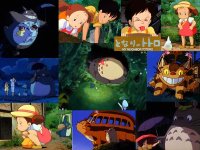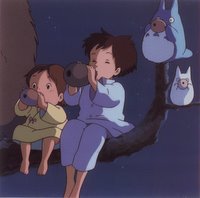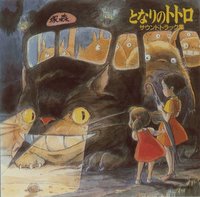 For some reason, I've decided not to do my reviews of the Ghibli films in order of release. Instead I'll continue with one of the most loved - Tonari no Totoro (My neighbour Totoro). There are times when a film has had so many recomendations that it can't possibly live up to the hype. Sadly for me, several Ghibli films fall into this category. I first bought Totoro as an R3HK import in summer 2004. I'd read so many things about it ("best Ghibli film ever", "the bus stop sequence is perfect" etc) that I was expecting the best anime of all time. Of course, it wasn't annd I was disappointed. The recent UK release rekindled my interest if only because it wasn't an NTSC-PAL conversion (if you don't know what that means - don't worry) so I thought I'd rebuy it and give it another viewing. I'm very glad I did as it's an amazing film. It's the sort of film that will make anyone nostalgic for their childhoods when we had no stresses about work, exams, jobs and relationships. Seen through the eyes of Satsuki and her younger sister Mei (both names comming from the month of May). It is set in rural Japan, possibly in the 1950s. Together with their father, an academic at Tokyo university, the girls move to the countryside to be nearer the hospital where their mother is recuperating. It's never said what actually wrong with her, but it's been suggested that she is recovering from TB (a desease Miyazaki's mother suffered from). The wonderful thing about this film, as with much of Miyazaki's magically heart-warming stories, is that there is no plot. This is simply a story that is seen from a child's view of the world. There are no evil baddies, no hint of peril of fears that must be overcome - simply a story. Much of the first half of Totoro sets up the girls' curiosity at their new surroundings. From the "dust bunnies" which seem to flee from sight whenever light is allowed into darkened areas, to the residents of the small village that the girls now call home. Eventually we meet the fantastic creatures that are the Totoros. Mei, exploring by herself whilst Satsuki is at school, catches sight of a small white creature which runs underneath the house. As Mei waits patiently by the hole she assumes is the only way back out, we see the creature, now joined by a bigger blue totoro creep past her carrying a sack full of acorns.
For some reason, I've decided not to do my reviews of the Ghibli films in order of release. Instead I'll continue with one of the most loved - Tonari no Totoro (My neighbour Totoro). There are times when a film has had so many recomendations that it can't possibly live up to the hype. Sadly for me, several Ghibli films fall into this category. I first bought Totoro as an R3HK import in summer 2004. I'd read so many things about it ("best Ghibli film ever", "the bus stop sequence is perfect" etc) that I was expecting the best anime of all time. Of course, it wasn't annd I was disappointed. The recent UK release rekindled my interest if only because it wasn't an NTSC-PAL conversion (if you don't know what that means - don't worry) so I thought I'd rebuy it and give it another viewing. I'm very glad I did as it's an amazing film. It's the sort of film that will make anyone nostalgic for their childhoods when we had no stresses about work, exams, jobs and relationships. Seen through the eyes of Satsuki and her younger sister Mei (both names comming from the month of May). It is set in rural Japan, possibly in the 1950s. Together with their father, an academic at Tokyo university, the girls move to the countryside to be nearer the hospital where their mother is recuperating. It's never said what actually wrong with her, but it's been suggested that she is recovering from TB (a desease Miyazaki's mother suffered from). The wonderful thing about this film, as with much of Miyazaki's magically heart-warming stories, is that there is no plot. This is simply a story that is seen from a child's view of the world. There are no evil baddies, no hint of peril of fears that must be overcome - simply a story. Much of the first half of Totoro sets up the girls' curiosity at their new surroundings. From the "dust bunnies" which seem to flee from sight whenever light is allowed into darkened areas, to the residents of the small village that the girls now call home. Eventually we meet the fantastic creatures that are the Totoros. Mei, exploring by herself whilst Satsuki is at school, catches sight of a small white creature which runs underneath the house. As Mei waits patiently by the hole she assumes is the only way back out, we see the creature, now joined by a bigger blue totoro creep past her carrying a sack full of acorns.  Eventually Mei sees them and gives chase with the excitement of a child that's found an amazing new toy. She winds up in the Totoros' layer under a tree. Lying asleep is a giant Totoro. Instead of being affraid, Mei is delighted by the giant furry creature which doesn't seem to mind her at all. When she tells her sister and father about her encounter, they don't disbelieve her as would happen in most western stories and Satsuki even writes to her mother telling her about Mei's encounter. Now we come to the famous bus stop scene. Whilst waiting for their fathers' bus to return from Tokyo, the girls are joined by the giant Totoro, who is getting wet with only a leaf for protectin from the rain. When Satsuki offers him an umbrella, Totoro studies it curiously and is delighted with the sound of rain on the canvas. When his special bus appears he gives the girls a pouch of seeds as a thank you. After planting the seeds, the girls have a night time encounter with the Totoros that again conjours up images of Raymond Briggs' The Snowman - the next day, they are gone, but some evidence of their adventure remains "It was a dream," shouts Satsuki, "but it wasn't a dream!"
Eventually Mei sees them and gives chase with the excitement of a child that's found an amazing new toy. She winds up in the Totoros' layer under a tree. Lying asleep is a giant Totoro. Instead of being affraid, Mei is delighted by the giant furry creature which doesn't seem to mind her at all. When she tells her sister and father about her encounter, they don't disbelieve her as would happen in most western stories and Satsuki even writes to her mother telling her about Mei's encounter. Now we come to the famous bus stop scene. Whilst waiting for their fathers' bus to return from Tokyo, the girls are joined by the giant Totoro, who is getting wet with only a leaf for protectin from the rain. When Satsuki offers him an umbrella, Totoro studies it curiously and is delighted with the sound of rain on the canvas. When his special bus appears he gives the girls a pouch of seeds as a thank you. After planting the seeds, the girls have a night time encounter with the Totoros that again conjours up images of Raymond Briggs' The Snowman - the next day, they are gone, but some evidence of their adventure remains "It was a dream," shouts Satsuki, "but it wasn't a dream!"As with the later Kiki's delivery service, the last act features a bit of suspense. While Kiki must overcome her self-doubt, in Totoro it is a outburst from Satsuki, upset at a cancellation of a visit from their mother, that upsets Mei and triggers the final meeting with the Totoros.
The wonder of the film is how Miyazaki captured the spirit of the 2 girls.
 Even though grown-ups can't see the Totoros or their magical friends, at no time does the film go into the western stereotype of the adults not believing the children, but like The Snowman we are left with a wonderful daydream of a film in which the fantastical story we're seeing is magical enought that we want it to be true. Miyazaki has said that after the end of the film, the girls never saw the Totoros again (although a short film produced for the Ghibli Museum, Mei and the kittenbus suggests this might not be true) much like James loses his snowman. If you enjoyed Kiki's Delivery Service, it's almost certain you'll love this film too and vice versa. The new English dub, starring the Fanning sisters isn't really needed (and the American pronunciation of Totoro is very annoying), there is such little dialogue that the Japanese track is the way to go (especially with the new literal subtitles). I'm so glad I gave this film another chance. It makes you yearn to be a child again and brings back memories of lazy summer days when things were a lot simpler. As for Totoro himself, he went on to become the official Ghibli mascot, appearing in the Ghibli banner before all their films. It's very strange to think that this film was nearly never made, as funding was withheld until plans were drawn up to premiere this film alongside Isao Takahata's Grave of the fireflies which must have been one of the most bipolar double features of all time.
Even though grown-ups can't see the Totoros or their magical friends, at no time does the film go into the western stereotype of the adults not believing the children, but like The Snowman we are left with a wonderful daydream of a film in which the fantastical story we're seeing is magical enought that we want it to be true. Miyazaki has said that after the end of the film, the girls never saw the Totoros again (although a short film produced for the Ghibli Museum, Mei and the kittenbus suggests this might not be true) much like James loses his snowman. If you enjoyed Kiki's Delivery Service, it's almost certain you'll love this film too and vice versa. The new English dub, starring the Fanning sisters isn't really needed (and the American pronunciation of Totoro is very annoying), there is such little dialogue that the Japanese track is the way to go (especially with the new literal subtitles). I'm so glad I gave this film another chance. It makes you yearn to be a child again and brings back memories of lazy summer days when things were a lot simpler. As for Totoro himself, he went on to become the official Ghibli mascot, appearing in the Ghibli banner before all their films. It's very strange to think that this film was nearly never made, as funding was withheld until plans were drawn up to premiere this film alongside Isao Takahata's Grave of the fireflies which must have been one of the most bipolar double features of all time.Most people will pull out the Miyazaki theme of flying from his movies, but a much deeper theme, that permeates all the Ghibli films, not just Miyazaki's, is love. From Nausicaa's love for nature, Sophie's love for Howl and Gina's love for Marco (I'll mention the others is later reviews), here we have a close knit family - the 2 sisters rarely argue and Satsuki always looks after Mei. Their father, though hard-working, always makes time for his girls. It's the kind of idealistic family life that Miyazaki wants Japan (and the rest of us) to return to.
I'll try and post up some more review of Ghibli films over the weekend.

No comments:
Post a Comment